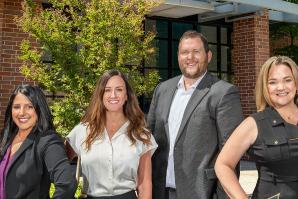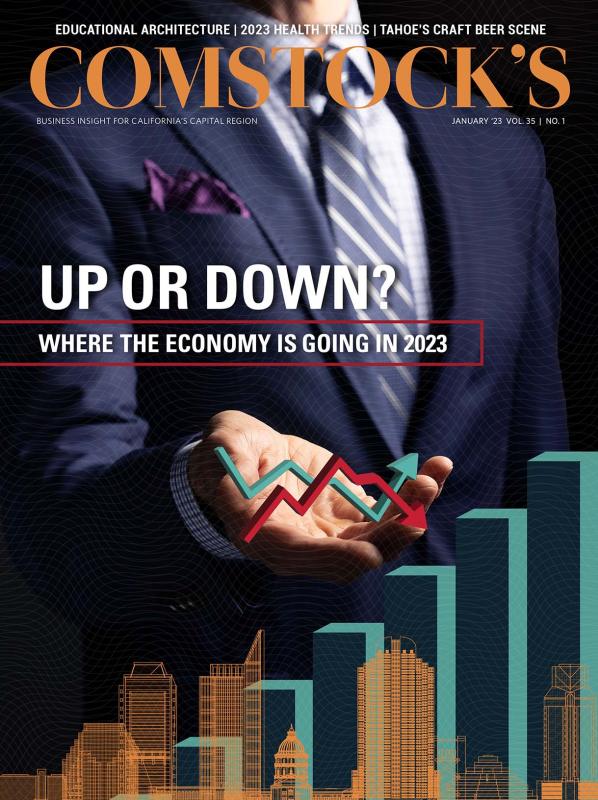Those who get paid to tell companies what to expect from the U.S. economy haven’t been a cheerful bunch of late. The National Association for Business Economics, a group of mostly corporate business economists, surveyed members in early October about conditions in their industries. The news was dismal: slowing sales growth, declining profit margins, rising prices. Fifty-three percent thought the country would enter a recession by the third quarter of 2023. Eleven percent said it’s in one already.
It’s just one of several warning signs about the national economy. In November, a group of large tech companies announced hiring freezes and layoffs. Interest rates are at their highest level in 14 years, and inflation at its highest since 1982. October brought a yield curve inversion — when short-term interest rates exceed long-term rates — and such inversions have reliably predicted recessions or slowdowns within six months to two years going back to 1955.
That’s not what Mike Testa sees locally. Sacramento’s GoldenSky Country Festival in October was expected to draw 30,000 people but brought in 50,000, says Testa, president and CEO of Visit Sacramento. Ironman California in October drew 4,000 athletes, the largest Ironman in North America, he adds. Sacramento will host parts of the NCAA’s March Madness and is bidding on the NCAA women’s basketball Final Four. As of October, bookings for the downtown convention center were running at 95 percent of Visit Sacramento’s goal for 2023, 85 percent for 2024 and — this is not a misprint — 13,000 percent for 2028, he says. According to a large hotel that shared proprietary data with Testa and declined to be identified, leisure stay sales were up 200 to 1,000 percent from 2019 to 2022, depending on the booking type.
Sales growth trailing three zeros doesn’t sound like recession to Testa. “I’m optimistic. We were on this precipice of exploding in a really good way before the pandemic hit,” he says. “And so the good news is we don’t have to rebuild from scratch.”
Other area business leaders aren’t feeling the gloom either. Unemployment is a rock-bottom 4 percent. Companies are relocating here to stay close to talent that fled the Bay Area during the pandemic. Placer and El Dorado counties are tops in the state for population growth and job creation. And the pandemic showed that parts of the region — particularly San Joaquin County — have economic clusters that make them able to ride out a recession. Through at least the first half of 2023, those who pay attention to Sacramento think the economy will do just fine; though the national picture still means companies should hedge against risk.
The bad
It’s difficult to make predictions, especially about the future, the saying goes. Unforeseeable events can upend the best forecasts, whether it’s a virus lurking in China or a major power using a nuclear weapon. “Tomorrow, let’s say Russia does decide to drop a nuclear bomb somewhere, right? Do you think that’s going to change the equation? Of course,” says Sanjay Varshney, chief economist for the Sacramento Business Review, which looks at where the region has been and might be going (and is a member of Comstock’s editorial advisory board).
Bad news first: There’s plenty that could pull down the local economy. The mid-year issue of SBR, which primarily covers El Dorado, Placer, Sacramento, Sutter, Yolo and Yuba counties, notes that workers’ average weekly earnings are up about 4 percent, but with inflation running 9 percent, that’s a net drop in purchasing power. SBR notes that consumer sentiment in the region has fallen to its lowest level since the inception of its consumer sentiment survey in 2018.
In the meantime, Goldman Sachs, JP Morgan and Twitter say they want workers back in the office full time, according to published reports. If that sentiment spreads, employees who moved to the Capital Region from the Bay Area during the pandemic shutdowns might have to either move back or find jobs locally. “So now you ask the question, if these people who are in the high-tech area making six-figure paychecks get displaced or they are forced to voluntarily quit because they cannot handle the commute, what jobs exist here that they can take to keep the economy vibrant?” asks Varshney.
In a government town, state deficits could mean furloughs. On November 16 the State Legislative Analyst’s Office forecast a budget deficit of $24 billion in 2023-24 because of lower-than-expected revenues.
Testa worries about crime and homelessness. After shootings this year, his group got calls from conventioneers wondering whether it’s safe downtown, and convention-goers comment on the number of unhoused people. With many state government employees still working from home, not as many downtown restaurants are serving, which hurts tourism, he says.
Mike Testa, president and CEO of Visit Sacramento, says bookings
for the downtown convention center and music festivals are very
high in 2023. (Photo by Wes Davis)

And of course there’s the housing crisis, which is causing business hiring problems, among others. Varshney says his calculations show that those with household incomes of close to $100,000 a year can afford fewer than 10 percent of Sacramento’s listings; those at $50,000 can afford fewer than 0.3 percent.
The wildcard might be the drought. New subdivisions won’t be built if developers can’t get water to their job sites, says Ken Monroe, president of Holt of California, a Caterpillar dealer with locations in Pleasant Grove, Stockton and Los Banos. Another year like this one with little snow and rain could have a drastic impact on sales, he says.
The good
For all that, the region has more going for it than not entering the new year. The percentage of small businesses in the region likely to hire is in line with the historical level, according to the SBR. The number of housing permits issued and apartments under construction hit six-year highs in 2021.
To the south in San Joaquin County, the 2013 arrival of Amazon has transformed the economy. Before that the county was adding about 1,000 jobs a year in transportation and warehousing. Now it’s about 6,000, says Thomas Pogue, director of the University of the Pacific’s Center for Business and Policy Research. The growth of e-commerce put the level of employment in those sectors on par with places like the Texas-Mexico border. “It’s an incredible concentration of transportation and warehousing,” says Pogue. With the online economy a mainstay of county employment and more people shopping online, especially during the pandemic, San Joaquin seems like it would be “pretty resilient” in a recession, says Pogue.
Placer County continues to be a dynamo. A 2021 Caltrans economic five-year forecast projected it to have the fastest population growth rate in the state and one of the fastest job creation growth rates through 2026.
Roseville City Council member Scott Alvord says he’s seeing reports showing strong household incomes, employment levels and consumer demand. Companies are moving in: Alvord notes that Quick Quack, the country’s fourth-largest car wash company, had its headquarters in Roseville and now has moved its manufacturing operation there too. Costco is moving forward with a second Roseville location. And the Westfield Galleria has big new brands, including Gucci, announcing openings.
“I think there’s more political rhetoric out there than real evidence of financial distress in our economy, especially in our region,” Alvord writes in an email. And the city has for years been fiscally conservative, setting aside significant reserve, rate stabilization and replacement funds for a downturn, he says.
In El Dorado County, Caltrans estimates an almost 3 percent a year rate of job growth between 2022 and 2026, the fastest of any county in California.
Will Austin, director of market analytics at the CoStar Group in West Sacramento, saw the start of another positive trend during the pandemic: firms following talent here. He points to HCL Technologies’ announcement of a move to the Capitol Mall; global semiconductor company Solidigm’s plans to open a campus in Rancho Cordova; biotech company Orca Bio building a 100,000-square-foot commercial facility at Metro Air Park; and CPC Scientific opening a new 41,000-square-foot facility in Rocklin. “There’s movement to Sacramento in a way that we haven’t seen,” says Austin. “By and large, companies follow talent. … And what’s interesting is the pandemic has really shown that people are willing and would like to live here, but their jobs aren’t here.”
“There’s movement to Sacramento in a way that we haven’t seen. By and large, companies follow talent. … And what’s interesting is the pandemic has really shown that people are willing and would like to live here, but their jobs aren’t here.”
Dustin, Director of market analytics, CoStar Group in West Sacramento
And in the multifamily market there’s movement back to the urban core. “As rents go up, renters are saying, well I can pay $2,500 a month to live in Citrus Heights or I can pay $2,700 a month to live in a brand-new building in West Sacramento,” says Austin. “That’s going to affect the restaurants immediately surrounding the Golden 1 Center. … As people move to the downtown core, you’ll see downtown come back to life a little bit more.”
Statewide there are some good signs, too. A June report from the UCLA Anderson School of Management forecast that inflation would slow to 3.5 percent in 2023. And the state will always be hard for investors to ignore as the world’s fourth-largest economy, with estimates suggesting its GDP passed that of Germany this year.
One California economist begs to differ on the prospects for recession nationally too.
“Honestly, you’re not going to have a recession when there’s so much pent-up consumer demand,” says economic forecaster Christopher Thornberg, founding partner at LA-based Beacon Economics. “It’s so weird when our labor markets have a record-tight unemployment rate, when earnings growth is at a 40-year high, when industrial production is at a peak level, when we still have half again as many job openings today as we did pre pandemic. Our economy continues to run at full bore,” he says.
Indeed, two bellwethers suggest no recession at least in the short term. Forecasters use the Architecture Billings Index, a monthly survey of architectural firms, to help predict what’s coming in nonresidential construction nine to 12 months out. In the September survey, more firms reported increased billings than didn’t, and work backlogs for architects remained at record-high levels. Thirty-six percent of firms expect increased revenues in 2023, and 30 percent foresee a decrease.
Another leading indicator is Caterpillar, whose sales take the temperature on construction and infrastructure investment because they require big capital outlays. The company’s latest figures suggest good things ahead: Sales and revenue were up 21 percent in third-quarter 2022, the latest reporting quarter. At the dealer level, Monroe says 2022 has been an up year for Holt of California, which serves the Central Valley. Most of their customers are busy and say they’ll stay that way at least through the first part of next year. Given how busy their customers have been, “if they stayed equally busy and we were flat, it would still be a strong economy,” he says.
How to plan
For all that, smart companies should hedge against a possible reversal by streamlining, assuming that revenues will take a hit if a recession does show up, says Varshney. Cost structures that may have looked fine the last few years because of federal COVID relief have changed because that money is no longer there, he says. “If a recession hits, you’re obviously going to have earnings that are going to come under huge pressure. So good companies obviously have to worry about these things,” says Varshney.
Sanjay Varshney, cheif economist for the Sacramento Business
Review and a member of Comstock’s editorial advisory board, says
companies should always be prepared for an economic downturn,
just in case. (Photo by Wes Davis)

Longer term the region’s decisionmakers can take some control over the direction of the area’s economy by tackling issues like housing and crime. That’s why area businesses need to be engaged in public policy, says Amanda Blackwood, president and CEO of the Sacramento Metropolitan Chamber of Commerce. “Business people, we need you to run for office. We need you to be on those boards. … The folks in those seats will determine your future.”
Varshney of the Sacramento Business Review has plenty of worries about the state: chronic underinvestment in housing and in the electrical grid at a time the state is requiring sales of electric-only passenger cars by 2035, the high cost of living and high taxes. But in the short term he thinks the area’s economy has enough going for it into next year.
“If you ask me, with no major shock to the system, do you think the current economy has enough strength to be sustainable into the next year?” he says. “The answer is yes. I don’t think Sacramento is going to collapse in the next year. The strength is there.”
–
Stay up to date on business in the Capital Region: Subscribe to the Comstock’s newsletter today.
Recommended For You

A Bright Outlook
Business leaders say they expect growth in 2022
We interviewed a local banking expert about how optimistic
national trends are being reflected in the Capital Region.

On the Rebound
How regional leaders are relaunching their local economies after the pandemic
The pressure is on to execute an economic comeback. Local
business and government leaders share their economic development
strategies for moving on from the bruising pandemic
economy.
Sponsored

Improving The Financial Success of Businesses Throughout California
Tri Counties Bank
Tri Counties Bank offers comprehensive financial solutions rivaling those of larger banks, but with the flexibility and superior level of service expected of a community bank.

What It Takes to Sell Your Business
Six Steps to Selling and Retiring
It’s crucial to a successful sale to take steps to
optimize how your business will be valued. Executive
business coach Brett Sargent outlines his model for selling a
business and retiring with ease.




